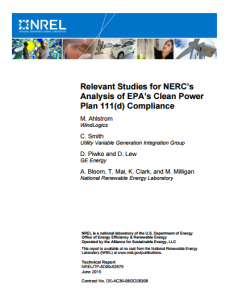Full Title: Relevant Studies for NERC’s Analysis of EPA’s Clean Power Plan 111(d) Compliance
Author(s): M. Ahlstrom, C. Smith, D. Piwko, D. Lew, A. Bloom, T. Mai, K. Clark, and M. Milligan
Publisher(s): National Renewable Energy Laboratory
Publication Date: June 1, 2015
Full Text: Download Resource
Description (excerpt):
The proposed Environmental Protection Agency (EPA) Clean Power Plan (CPP) aims to cut carbon dioxide (CO2) missions from existing power plants to 30 percent below 2005 levels by 2030. The North American Electric Reliability Corporation (NERC) is preparing a series of reports to examine possible reliability concerns from the required change in the generation mix needed to achieve this target. In addition to describing their own analysis, NERC plans to highlight and summarize relevant and technically sound studies completed by other parties.
The purpose of this paper is to describe multiple studies of wind and solar integration that have found CO2 reductions of approximately 30%. These studies can be viewed in several ways, including as viable paths to compliance with the EPA rule, alternative “bookend cases” to compare to compliance based largely on natural gas, or something in between. The studies in this paper represent a body of work that can help inform the public discussion surrounding the cost and reliability impacts of complying with the proposed EPA CPP.
Although it is possible to assume that a large-scale transition from coal to natural gas generation is the primary path to CPP compliance, there are actually many available paths toward compliance, and states will have significant flexibility in their approaches. Another path toward compliance emphasizes the use of wind and solar energy, and it has been studied very extensively during the past 15 years. Several recent wind and solar integration studies focused on power system operations, reliability, and stability while reducing CO2 emissions by 30% or more.
The summaries that follow were initially drafted by principal investigators or technical review committees for each study and then edited to a consistent format. Not all studies examined all aspects of maintaining operational balance or reliability, but as a group these studies have examined a wide range of operational and reliability implications. We hope that this document assists NERC’s efforts to include this relevant material in their reports. And more generally, we hope that this report is useful in showing that a 30% CO2 reduction has already been extensively studied, and the body of work taken as a whole shows that reliable and cost-effective compliance is possible.
